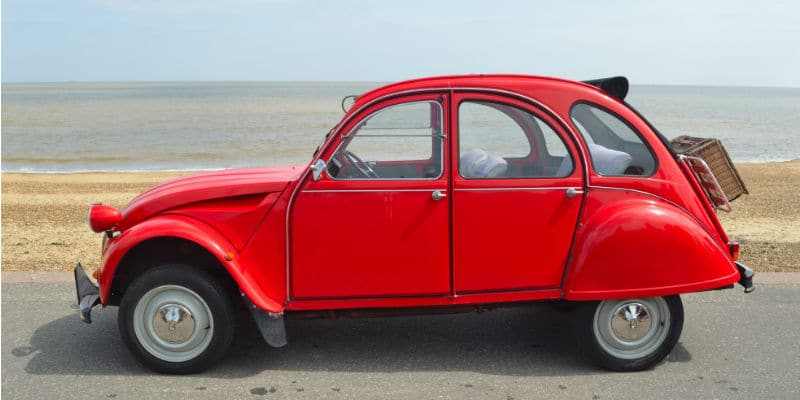Last May, thousands of people from across Europe made a pilgrimage to an annual celebration in Saint-Amand Montrond, an inconspicuous town in the center of France. The purpose behind this unlikely gathering? A shared affection for a clunky, quirky automobile that has been out of production for almost three decades: the Citroën 2CV.
The 2CV (pronounced “deux chevaux,” or “two horses” in English) is nothing short of a legend in France. After its release in 1948, people quickly grew to love the car for many reasons—including its affordability, quirky design, and unapologetic practicality—but perhaps more than anything, because it helped French people and their economy get rolling again, both figuratively and literally, after the devastation of the First and Second World Wars.
Following the destruction of WWII, France had fewer than 100,000 cars left on its roads, down from two million before the war. In a country with 40 million people, transportation was a challenge. This was especially true for those living in the countryside, where cars were scarce even before the war, and horse-drawn carts and bicycles were still overwhelmingly the primary mode of transport.
This problem was apparent to Pierre-Jules Boulanger, chairman of the French carmaker Citroën. The few cars at the time were owned mostly by the wealthy, but rather than target existing consumers with new models, Boulanger made a bet that his struggling company could find success by selling simple, practical automobiles to France’s rural farmers. Boulanger famously told his designers to “Build me an umbrella with four wheels.”
As it turned out, even Boulanger couldn’t have guessed the demand his car would generate. It sold out in its first year on the market, and the waiting list quickly grew from months to years to receive one. The company would go on to sell millions in the ensuing decades, and, in retrospect, it’s no coincidence. Boulanger’s strategy behind the 2CV holds four valuable lessons for innovators and entrepreneurs today.
1. See the opportunity in nonconsumption
Nonconsumption is the inability of people to use a product from which they would otherwise benefit because it is too expensive, complicated, or inaccessible. There was vast nonconsumption of automobiles in rural France after WWII, but most automobile executives assumed it didn’t make sense to try selling cars—which at the time were luxury items—to a low-income population.
However, Boulanger saw an opportunity. He knew he didn’t need to compete with the best cars on the market; he just needed to build a better option than using a horse or bicycle. If he could do that while ensuring it remained affordable, he would be able to create a brand new market with millions of potential customers. By spotting an opportunity that others missed, Boulanger gained enormous returns from the market his product created.
2. Remove the barriers to consumption
In post-WWII France, many people in rural, lower-income areas didn’t own cars because they were too expensive, they were complicated and difficult to repair, and they were ill-suited to driving through fields and dirt roads where people needed to use them. Boulanger made a point to deliberately address all three of these barriers to consumption.
First, he challenged his designers to include only the necessary features, lowering the car’s cost to just over $700 (original prototypes went as far as including only one headlight and installing hammock-style seats hung from the roof). Second, Boulanger demanded that the car be usable by people with no experience in machinery since most customers lived far away from any type of mechanic. Third, the 2CV included a robust suspension system. Boulanger famously required the car to transport a basket of fresh eggs across a plowed field without breaking any of them.
3. Zero in on the customer’s Job to Be Done
When people buy a product, they do so hoping it will help them make progress in some way. We refer to this progress as the customer’s “job” they are trying to accomplish. One job Boulanger knew many of his customers would encounter was transporting people and goods on bumpy roads from farms to markets. In addition to the plush suspension mentioned above, the 2CV was specifically built to carry four adults and at least 50 kilograms of potatoes, or (in classic French fashion) a cask of wine in the back. Boulanger also rejected any designs that didn’t allow him to wear his top hat inside, as he knew it would be inconvenient for the many people using the car to ride to church while wearing their Sunday-best.
Boulanger succeeded because he didn’t just build a new car; he built a solution to the specific problems and tasks his customers encountered on a daily basis. Even though contemporary designers poked fun at its quirky design (it was often called the “tin snail” or the “flying dustbin” in Britain), Citroën’s new customers loved it.
4. Innovation’s impact can stretch far beyond just a product
When innovators make affordable and accessible products for lower-income segments of the population that couldn’t enjoy them before, the impact is always larger than the individual product.
Ultimately, the 2CV earned its place in the heart of French culture because it generated a wave of previously unknown prosperity across France’s rural, lower-income regions. Its production created jobs in Citroën’s factories and sales departments, but it also greatly boosted the productivity of France’s rural farmers, doctors, midwives, veterinarians, and others for whom the car was designed. Perhaps most importantly, it connected rural France’s population to the rest of the country, spurring investment in interior regions, as well as giving people dignity and a larger role in the country’s modernizing postwar society. Altogether, it’s easy to see why the quirky 2CV continues to hold its place in so many French hearts.



